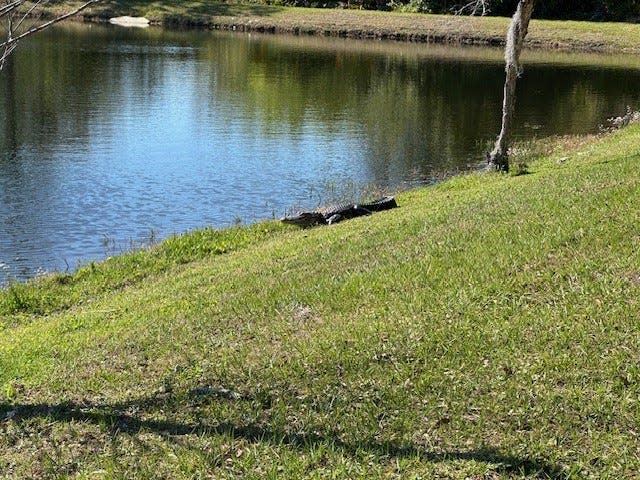The St. Augustine Record meets an alligator

While strolling along the San Sebastian River, I met an alligator lounging gracefully on the grassy knoll. I didn’t realize it was an alligator until I was but 4 feet away from the majestic creature. I froze, trying to remember what to do when passing an alligator lounging on the green. I'm sure I read instructions somewhere. Do you scream and yell loudly and wave your hands wildly and make believe you’re 6’9” or do you run like a wild turkey?
Remember nothing, I gingerly stepped backwards while snapping a photo. The camera’s click caused the creature to speed into the water and swim away. Once home, I researched all things alligator.
According to the Florida Fish and Wildlife Conservation Commission (FWC), alligators have inhabited Florida’s marshes, swamps, rivers, and lakes for centuries. And while we – Floridians – have learned how to co-exist with alligators, the state’s recent population explosion has increased the frequency of alligator-people interactions.
Just in case you’re passing by an alligator, the FWC advises to keep your distance, because alligators are “opportunistic feeders.” The diet of an adult alligator includes fish, snakes, turtles, small mammals and birds. (No mention of humans weighing in at 102 pounds). Juvenile alligators eat insects, amphibians, small fish and other invertebrates; safe again.
But the news for babies is alarming.
“Small alligators are eaten by a variety of predators including raccoons, otters, wading birds, and fish; however, larger alligators may be their most significant predator,” said the FWC website.
Great; not even the kids are safe.
The FWC also noted that adult alligators are mostly consumed by alligator cannibalism, intraspecific fighting, and humans.
The life of alligator eggs is also questionable. Mamma alligators do their best.
“Females build a mound nest of soil, vegetation, or debris and deposit an average of 32 to 46 eggs in late June or early July,” said the FWC website. “Incubation requires approximately 63-68 days, and hatching occurs from mid-August through early September.”
However, most eggs fall prey to drowning, being crushed by mom and/or other predators such as raccoons, hogs, otters and bears. Twenty-five baby gators will hatch; 10 will live for a year, and five will reach maturity.
The FWC also warns people to never feed an alligator; it’s illegal and not wise for alligators to associate humans with food availability. (Good to know.) Other suggestions including swimming in designated swimming areas during the day because alligators are most active between dusk and dawn, and keeping your pets leashed and away from the embankment.
But the most interesting fun fact described the courtship of an alligator, which begins in April for mating in May and June.
“As the weather gets warmer across the Sunshine State, alligators are becoming more active and visible,” said the FWC.
Oh, that explains it. I met an alligator looking for romance. Oh, be still my heart.
But the news is good, for there is hope.
“Serious injuries caused by alligators are rare, but if you are concerned call FWC’s toll-free Nuisance Alligator Hotline at 866-392-4286. The FWC will dispatch one of its contracted nuisance alligator trappers to resolve the situation.”
This article originally appeared on St. Augustine Record: The St. Augustine Record meets an alligator. Do you know what to do if you meet one?

